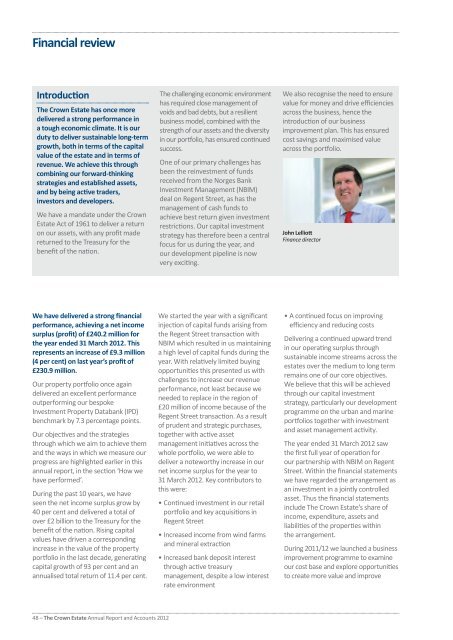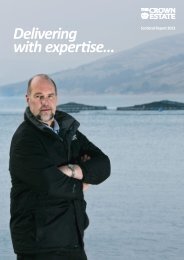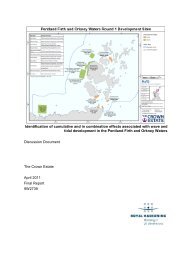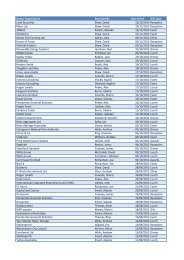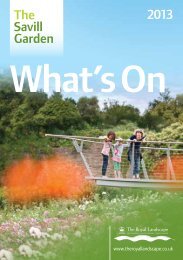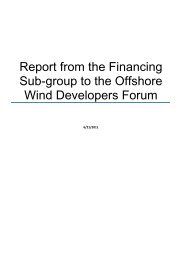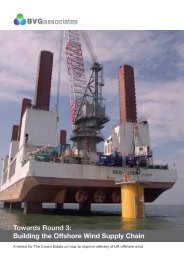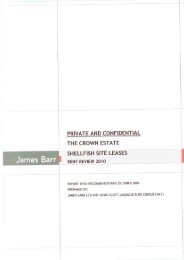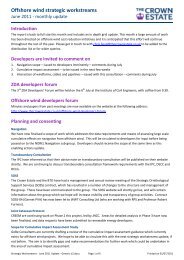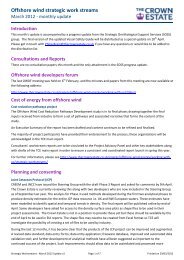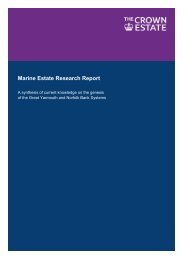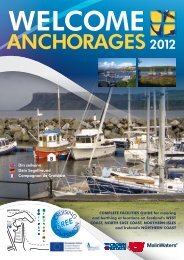Financial review - Annual report and accounts 2012 - The Crown ...
Financial review - Annual report and accounts 2012 - The Crown ...
Financial review - Annual report and accounts 2012 - The Crown ...
You also want an ePaper? Increase the reach of your titles
YUMPU automatically turns print PDFs into web optimized ePapers that Google loves.
<strong>Financial</strong> <strong>review</strong><br />
Introduction<br />
<strong>The</strong> <strong>Crown</strong> Estate has once more<br />
delivered a strong performance in<br />
a tough economic climate. It is our<br />
duty to deliver sustainable long-term<br />
growth, both in terms of the capital<br />
value of the estate <strong>and</strong> in terms of<br />
revenue. We achieve this through<br />
combining our forward-thinking<br />
strategies <strong>and</strong> established assets,<br />
<strong>and</strong> by being active traders,<br />
investors <strong>and</strong> developers.<br />
We have a m<strong>and</strong>ate under the <strong>Crown</strong><br />
Estate Act of 1961 to deliver a return<br />
on our assets, with any profit made<br />
returned to the Treasury for the<br />
benefit of the nation.<br />
<strong>The</strong> challenging economic environment<br />
has required close management of<br />
voids <strong>and</strong> bad debts, but a resilient<br />
business model, combined with the<br />
strength of our assets <strong>and</strong> the diversity<br />
in our portfolio, has ensured continued<br />
success.<br />
One of our primary challenges has<br />
been the reinvestment of funds<br />
received from the Norges Bank<br />
Investment Management (NBIM)<br />
deal on Regent Street, as has the<br />
management of cash funds to<br />
achieve best return given investment<br />
restrictions. Our capital investment<br />
strategy has therefore been a central<br />
focus for us during the year, <strong>and</strong><br />
our development pipeline is now<br />
very exciting.<br />
We also recognise the need to ensure<br />
value for money <strong>and</strong> drive efficiencies<br />
across the business, hence the<br />
introduction of our business<br />
improvement plan. This has ensured<br />
cost savings <strong>and</strong> maximised value<br />
across the portfolio.<br />
John Lelliott<br />
Finance director<br />
We have delivered a strong financial<br />
performance, achieving a net income<br />
surplus (profit) of £240.2 million for<br />
the year ended 31 March <strong>2012</strong>. This<br />
represents an increase of £9.3 million<br />
(4 per cent) on last year’s profit of<br />
£230.9 million.<br />
Our property portfolio once again<br />
delivered an excellent performance<br />
outperforming our bespoke<br />
Investment Property Databank (IPD)<br />
benchmark by 7.3 percentage points.<br />
Our objectives <strong>and</strong> the strategies<br />
through which we aim to achieve them<br />
<strong>and</strong> the ways in which we measure our<br />
progress are highlighted earlier in this<br />
annual <strong>report</strong>, in the section ‘How we<br />
have performed’.<br />
During the past 10 years, we have<br />
seen the net income surplus grow by<br />
40 per cent <strong>and</strong> delivered a total of<br />
over £2 billion to the Treasury for the<br />
benefit of the nation. Rising capital<br />
values have driven a corresponding<br />
increase in the value of the property<br />
portfolio in the last decade, generating<br />
capital growth of 93 per cent <strong>and</strong> an<br />
annualised total return of 11.4 per cent.<br />
We started the year with a significant<br />
injection of capital funds arising from<br />
the Regent Street transaction with<br />
NBIM which resulted in us maintaining<br />
a high level of capital funds during the<br />
year. With relatively limited buying<br />
opportunities this presented us with<br />
challenges to increase our revenue<br />
performance, not least because we<br />
needed to replace in the region of<br />
£20 million of income because of the<br />
Regent Street transaction. As a result<br />
of prudent <strong>and</strong> strategic purchases,<br />
together with active asset<br />
management initiatives across the<br />
whole portfolio, we were able to<br />
deliver a noteworthy increase in our<br />
net income surplus for the year to<br />
31 March <strong>2012</strong>. Key contributors to<br />
this were:<br />
• Continued investment in our retail<br />
portfolio <strong>and</strong> key acquisitions in<br />
Regent Street<br />
• Increased income from wind farms<br />
<strong>and</strong> mineral extraction<br />
• Increased bank deposit interest<br />
through active treasury<br />
management, despite a low interest<br />
rate environment<br />
• A continued focus on improving<br />
efficiency <strong>and</strong> reducing costs<br />
Delivering a continued upward trend<br />
in our operating surplus through<br />
sustainable income streams across the<br />
estates over the medium to long term<br />
remains one of our core objectives.<br />
We believe that this will be achieved<br />
through our capital investment<br />
strategy, particularly our development<br />
programme on the urban <strong>and</strong> marine<br />
portfolios together with investment<br />
<strong>and</strong> asset management activity.<br />
<strong>The</strong> year ended 31 March <strong>2012</strong> saw<br />
the first full year of operation for<br />
our partnership with NBIM on Regent<br />
Street. Within the financial statements<br />
we have regarded the arrangement as<br />
an investment in a jointly controlled<br />
asset. Thus the financial statements<br />
include <strong>The</strong> <strong>Crown</strong> Estate’s share of<br />
income, expenditure, assets <strong>and</strong><br />
liabilities of the properties within<br />
the arrangement.<br />
During 2011/12 we launched a business<br />
improvement programme to examine<br />
our cost base <strong>and</strong> explore opportunities<br />
to create more value <strong>and</strong> improve<br />
48 – <strong>The</strong> <strong>Crown</strong> Estate <strong>Annual</strong> Report <strong>and</strong> Accounts <strong>2012</strong>
We have delivered a strong financial performance, achieving a<br />
net income surplus (profit) of £240.2 million for the year ended<br />
31 March <strong>2012</strong>. This represents an increase of £9.3 million<br />
(4 per cent) on last year’s profit of £230.9 million.<br />
efficiency generally throughout the<br />
business. <strong>The</strong> programme has five<br />
principal objectives: a structure<br />
responsive to changing conditions;<br />
add value through asset management;<br />
optimise property performance<br />
through our partners; optimise<br />
expertise to drive value <strong>and</strong> cost<br />
effectiveness through business<br />
synergies; <strong>and</strong> ensure support functions<br />
are of an appropriate size <strong>and</strong> skill base<br />
providing good customer focus <strong>and</strong><br />
value for money. <strong>The</strong> impact of this<br />
programme is beginning to take shape<br />
as we have managed to reduce<br />
underlying costs this year. However<br />
we expect the full impact to be felt in<br />
<strong>2012</strong>/13 <strong>and</strong> 2013/14 as, during this<br />
year, we have laid the foundations for<br />
significant changes to the structure of<br />
the business through which we will<br />
continue to drive performance, savings<br />
<strong>and</strong> efficiencies.<br />
Net assets<br />
<strong>The</strong> capital value of <strong>The</strong> <strong>Crown</strong> Estate<br />
at 31 March <strong>2012</strong> was £8.1 billion, an<br />
increase of 11 per cent over its value<br />
of £7.3 billion at 31 March 2011.<br />
<strong>The</strong> increase in value is principally<br />
attributable to higher property<br />
valuations <strong>and</strong> higher cash reserves.<br />
Cash flow<br />
At the start of the year our cash<br />
reserve was £279.2 million. On 1 April<br />
2011 we received £452 million on the<br />
completion of the arrangement with<br />
NBIM on Regent Street. During the<br />
year our capital activity totalled<br />
£1 billion. This included acquisitions<br />
with a total value of £166.2 million;<br />
principally the purchases of Morfa<br />
Retail Park <strong>and</strong> South Aylesford Retail<br />
Park. Capital expenditure totalling<br />
£243.7 million was made which<br />
included £138.5 million on<br />
development projects, particularly on<br />
the urban central London estates, as<br />
well as a significant commitment to<br />
renewable energy. Disposals realising<br />
£639.7 million were made during the<br />
year. Overall, our capital activity led to<br />
a net inflow of funds of £211.7 million<br />
compared with a net outflow of<br />
£192.2 million in 2010/11.<br />
Assets under management<br />
Over the last few years we have seen a<br />
substantial increase in the amount of<br />
property that we manage on behalf of<br />
third parties. Assets under management<br />
were valued at £7.7 billion at 31 March<br />
<strong>2012</strong> of which directly owned property<br />
comprised £7.2 billion. Regent Street,<br />
which we manage on behalf of NBIM<br />
is the largest contributor to assets<br />
managed on behalf of third parties.<br />
<strong>The</strong> property portfolio<br />
<strong>The</strong> total property value of the estate,<br />
inclusive of share of joint venture <strong>and</strong><br />
other property investments, increased<br />
by 7.4 per cent to £7.6 billion for the<br />
year ending 31 March <strong>2012</strong>. In addition<br />
we also now have £539 million of<br />
assets under management. <strong>The</strong> key<br />
highlights include:<br />
• At £7.6 billion, this is the highest<br />
value the property portfolio has<br />
been at a financial year end<br />
• <strong>The</strong> urban portfolio is now valued at<br />
£5.5 billion <strong>and</strong> is back above<br />
pre-recession levels<br />
• <strong>The</strong> rural portfolio has grown by<br />
13 per cent to £1.2 billion<br />
• <strong>The</strong> marine portfolio has grown by<br />
24 per cent to £726 million<br />
• <strong>The</strong> Windsor estate has grown by<br />
5.4% to £196 million<br />
<strong>The</strong> urban portfolio has performed<br />
broadly in line with the market<br />
with our core West End properties<br />
outperforming the remainder of the<br />
portfolio. Across the West End we have<br />
seen capital growth of 10 per cent<br />
driven primarily by growth in rental<br />
values with a slight compression of<br />
yields over the year. Outside of London<br />
the market has been much more<br />
challenging with secondary assets<br />
falling in value. However, due to the<br />
prime nature of our stock, our values<br />
are largely unchanged on a year ago.<br />
Transactional activity was dominated<br />
by the creation of the Regent Street<br />
Partnership with NBIM on 1 April <strong>2012</strong><br />
which released £452 million. This<br />
provided further liquidity to focus the<br />
commercial portfolio on the West End<br />
<strong>and</strong> dominant retail holdings outside<br />
of London. In conjunction with NBIM<br />
we have invested over £100 million in<br />
Regent Street including the purchase<br />
of two headleases <strong>and</strong> one freehold<br />
<strong>and</strong> started the development of<br />
153–167 Regent Street. In St James’s<br />
we bought in Trafalgar House <strong>and</strong><br />
continued our development of<br />
St James’s Gateway. Several non-core<br />
disposals were made in London,<br />
Overview Performance Sustainability Governance <strong>Financial</strong>s<br />
<strong>The</strong> <strong>Crown</strong> Estate <strong>Annual</strong> Report <strong>and</strong> Accounts <strong>2012</strong> – 49
<strong>Financial</strong> <strong>review</strong> continued<br />
Our highly skilled, professional <strong>and</strong> experienced staff play<br />
a vital role in enabling us to deliver excellent financial results,<br />
in what has been a difficult year for the property sector <strong>and</strong><br />
the economy as a whole.<br />
including Fleet Place House,<br />
40 Holborn Viaduct <strong>and</strong> Dyott House<br />
on Oxford Street. At a total of £101<br />
million the proceeds raised were 24%<br />
higher than last year’s book value.<br />
Outside London we purchased two<br />
more retail parks in Swansea <strong>and</strong><br />
Maidstone <strong>and</strong> are currently forward<br />
funding the Stadium MK retail park in<br />
Milton Keynes which is due to open<br />
during <strong>2012</strong>. <strong>The</strong> total cost for these<br />
three investments was £188 million.<br />
Over the year, purchases <strong>and</strong><br />
investment management initiatives<br />
of commercial property totalled<br />
£261 million, development expenditure<br />
amounted to £101 million <strong>and</strong> sales of<br />
freeholds <strong>and</strong> long leaseholds raised<br />
£608 million.<br />
<strong>The</strong> rental value growth in the West<br />
End over the last few years has been<br />
driven more by a shortage of Grade A<br />
space rather than strong occupier<br />
dem<strong>and</strong>. This shortage has justified<br />
our foresight in 2008 to start<br />
developing the Quadrant which we<br />
completed in November 2011 <strong>and</strong> is<br />
now 60 per cent let. Over the year its<br />
value has increased by £152 million<br />
after £49 million of development<br />
expenditure.<br />
Prime residential property in London<br />
has performed particularly well on<br />
the back of international investment<br />
<strong>and</strong> we have seen our portfolio in<br />
Regent’s Park <strong>and</strong> Kensington increase<br />
by 21 per cent to £444 million. <strong>The</strong>se<br />
assets also generated £40 million from<br />
leasehold sales.<br />
<strong>The</strong> value of our rural portfolio has<br />
increased to £1.2 billion rising by<br />
13 per cent with net capital receipts of<br />
£43 million. <strong>The</strong> principle sales were of<br />
st<strong>and</strong>ing investments in Savernake <strong>and</strong><br />
Stapleford Abbots <strong>and</strong> l<strong>and</strong> sold with<br />
planning permission for residential<br />
development in Hemel Hempstead<br />
<strong>and</strong> Bingham. Tactical acquisitions<br />
were made of 63 acres at Elsenham<br />
in Essex adjacent to the M11 <strong>and</strong> 357<br />
acres on the edge of Lichfield.<br />
<strong>The</strong> fundamental driver of values<br />
across the portfolio is the increase in<br />
value of agricultural l<strong>and</strong> with vacant<br />
possession. This has been supported<br />
by an increase in rental values with the<br />
improved economic outlook for UK<br />
agriculture generating strong open<br />
market agricultural lettings. <strong>The</strong><br />
market continues to be characterised<br />
by a shortage of supply <strong>and</strong> strong<br />
dem<strong>and</strong> from farmers fuelled by<br />
commodity prices <strong>and</strong> the attraction<br />
of l<strong>and</strong> as a safe investment. On a<br />
regional basis, growth was particularly<br />
strong on commercial arable farms<br />
in East Anglia <strong>and</strong> the East Midl<strong>and</strong>s.<br />
Growth was weaker on the estates<br />
with a higher residential element.<br />
Marine has increased by 24 per cent<br />
to £726 million driven by an increase<br />
in the value of offshore wind farms<br />
<strong>and</strong> a change in our approach to the<br />
valuation of marine aggregates. <strong>The</strong><br />
increase in the wind farm valuation is<br />
largely due to more certainty over<br />
expected income. Last year there were<br />
37 approved schemes of which 16<br />
were generating <strong>and</strong> five were under<br />
construction. This year there are 41<br />
schemes of which 19 are generating<br />
<strong>and</strong> four are under construction.<br />
2.65 GW have now been installed<br />
with 1.54 GW under construction.<br />
<strong>The</strong> valuation is also reflective of<br />
market dem<strong>and</strong> for well-secured<br />
investment income <strong>and</strong> an increase in<br />
dem<strong>and</strong> for infrastructure <strong>and</strong> ‘green<br />
energy’ investments.<br />
<strong>The</strong> aggregates valuation is<br />
determined by the current proven<br />
reserves within a region <strong>and</strong><br />
the market dem<strong>and</strong> for marine<br />
construction aggregate. However the<br />
Marine Licensing Act was passed in the<br />
last year which now provides increased<br />
security of tenure to operators.<br />
<strong>The</strong> consequential increased security<br />
of income has lifted that valuation<br />
from £52 million to £106 million.<br />
<strong>The</strong> principal valuers remain DTZ on<br />
our core West End holdings, Jones<br />
Lang LaSalle on our regional <strong>and</strong><br />
residential properties <strong>and</strong> Savills<br />
on the rural portfolio.<br />
Regulatory framework<br />
<strong>The</strong> <strong>Crown</strong> Estate Act 1961, places<br />
certain obligations <strong>and</strong> restrictions<br />
on the way we do business <strong>and</strong> <strong>report</strong><br />
our financial results. <strong>The</strong>se include:<br />
• An inability to borrow in order to<br />
finance investment<br />
• Special accounting arrangements,<br />
similar to a trust, that aim to<br />
maintain a balance between income<br />
<strong>and</strong> capital<br />
• A requirement that our income<br />
account is kept separate from our<br />
capital account, with no element<br />
held for capital investment other<br />
than for very specific minor<br />
exceptions<br />
50 – <strong>The</strong> <strong>Crown</strong> Estate <strong>Annual</strong> Report <strong>and</strong> Accounts <strong>2012</strong>
<strong>The</strong> final point means that any capital<br />
investment can only be generated<br />
from capital activity or from permitted<br />
appropriations from income.<br />
In order to maintain the distinction<br />
between income <strong>and</strong> capital <strong>and</strong> at the<br />
same time comply with International<br />
<strong>Financial</strong> Reporting St<strong>and</strong>ards (IFRS),<br />
our statement of income <strong>and</strong><br />
expenditure is presented in a threecolumn<br />
format. This shows the<br />
contribution to the surplus from the<br />
income account <strong>and</strong> capital account<br />
separately.<br />
During 2011/12 legislation was passed<br />
<strong>and</strong> a fund launched, both of which<br />
referenced <strong>The</strong> <strong>Crown</strong> Estate.<br />
<strong>The</strong>se were as follows:<br />
Sovereign Grant – In October 2011<br />
the Sovereign Grant Act was passed<br />
by Parliament. It provides for the<br />
Sovereign Grant for a given year to be<br />
equal to 15 per cent of <strong>The</strong> <strong>Crown</strong><br />
Estate’s net revenue surplus (profit)<br />
in the financial year two years prior.<br />
<strong>The</strong> money to support this grant is<br />
provided by the Exchequer. This year’s<br />
net revenue surplus will form the basis<br />
for the first year in 2013/14.<br />
Coastal Communities Fund – In July<br />
2011 the Government announced the<br />
launch of <strong>The</strong> Coastal Communities<br />
Fund to support the economic<br />
development of coastal communities.<br />
<strong>The</strong> level of funding is linked to <strong>The</strong><br />
<strong>Crown</strong> Estate’s gross marine income.<br />
<strong>The</strong> money to support this Fund is<br />
provided by the Exchequer <strong>and</strong> not<br />
<strong>The</strong> <strong>Crown</strong> Estate.<br />
Neither the Sovereign Grant nor<br />
Coastal Communities Fund affect<br />
the way in which the managerial or<br />
operational functions of <strong>The</strong> <strong>Crown</strong><br />
Estate are performed. We continue<br />
to give our entire annual net revenue<br />
surplus to the Treasury. <strong>The</strong>y both<br />
simply provide a mechanism that will<br />
be used by the Treasury to determine<br />
the amount of Government funding<br />
for the Monarch <strong>and</strong> the Coastal<br />
Communities Fund.<br />
Charitable donations<br />
We provided one donation totalling<br />
£1,000 in the year ended 31 March<br />
<strong>2012</strong> (£17,000 in the year ended<br />
31 March 2011), as permitted by the<br />
<strong>Crown</strong> Estate Act 1961, section 4(2).<br />
Supplier payment<br />
performance<br />
<strong>The</strong> <strong>Crown</strong> Estate payment policy is<br />
to pay all suppliers within 30 days of<br />
receipt of a correctly documented<br />
invoice, or on completion of service<br />
where a fee is recoverable from a third<br />
party, or according to contract where<br />
a shorter payment period is agreed.<br />
During the year ended 31 March <strong>2012</strong>,<br />
we paid 69 per cent of invoices from<br />
suppliers within this period. <strong>The</strong> figures<br />
include invoices under dispute <strong>and</strong><br />
amounts recoverable from third<br />
parties. On average, invoices from<br />
suppliers are paid within 40 days of<br />
receipt. We observe the principles of<br />
the ‘Better Payment Practice Code’.<br />
Our employees<br />
Our highly skilled, professional <strong>and</strong><br />
experienced staff play a vital role<br />
in enabling us to deliver excellent<br />
financial results, in what has been a<br />
difficult year for the property sector<br />
<strong>and</strong> the economy as a whole. <strong>The</strong><br />
<strong>Crown</strong> Estate continues to be viewed<br />
as an attractive employer that recruits<br />
<strong>and</strong> retains highly skilled professionals.<br />
Our staffing body is part of the very<br />
fibre of what we do, as they ensure<br />
that the core values of commercialism,<br />
integrity <strong>and</strong> stewardship permeate<br />
every area of our business. This is<br />
enhanced by a strong customer focus<br />
which is integral to our continuing<br />
commitment to being great people to<br />
do business with across the breadth<br />
<strong>and</strong> diversity of our portfolios.<br />
In 2010, we took part in the Best<br />
Companies survey to support our<br />
goal of being in <strong>The</strong> Sunday Times’<br />
Top 100 companies to work for, <strong>and</strong> to<br />
underline the importance we place on<br />
creating a rewarding <strong>and</strong> fulfilling<br />
workplace. We achieved a ‘one to<br />
watch’ status, reflecting the<br />
commitment <strong>and</strong> pride that our<br />
employees have working for us.<br />
In response to the survey results, we<br />
have continued to invest in the delivery<br />
of a management <strong>and</strong> leadership<br />
programme, with 99 per cent of<br />
managers participating in a three day<br />
leadership programme during the<br />
course of 2011/12. <strong>The</strong> majority of<br />
participants <strong>report</strong>ed positive benefits<br />
from attending the programme <strong>and</strong><br />
many have <strong>report</strong>ed that they have<br />
made conscious step changes to the<br />
way in which they manage <strong>and</strong> lead<br />
people. We will be entering again in<br />
<strong>2012</strong> <strong>and</strong> hope to improve on our<br />
‘one to watch’ status.<br />
Our staff turnover remained stable at<br />
12 per cent in 2011/12 compared<br />
with 10 per cent in 2010/11.<br />
Pay <strong>and</strong> pensions<br />
Our reward arrangements come<br />
under regular <strong>review</strong>. In the main we<br />
continue to offer competitive packages<br />
in the current economic climate.<br />
<strong>The</strong> final phases of our revised reward<br />
strategy were completed last year,<br />
introducing ‘MyChoices’ as a flexible<br />
benefits reward platform.<br />
<strong>The</strong>se flexible <strong>and</strong> competitive<br />
reward policies <strong>and</strong> practices allow<br />
us to attract, retain <strong>and</strong> motivate<br />
employees <strong>and</strong> help to develop a high<br />
performance culture that supports the<br />
achievement of our business goals.<br />
This is particularly important to us for<br />
two major reasons: firstly, our reward<br />
policies need to be flexible <strong>and</strong><br />
competitive so that we retain the best<br />
employees through both good <strong>and</strong> bad<br />
times; secondly, given our considerable<br />
investment in the renewable energy<br />
sector, we need to offer remuneration<br />
packages that are competitive in this<br />
global market.<br />
Overview Performance Sustainability Governance <strong>Financial</strong>s<br />
<strong>The</strong> <strong>Crown</strong> Estate <strong>Annual</strong> Report <strong>and</strong> Accounts <strong>2012</strong> – 51
<strong>Financial</strong> <strong>review</strong> continued<br />
Total average number of employees<br />
during the year<br />
General Operating<br />
administration activities<br />
231 197<br />
Average percentage working days lost<br />
General Operating<br />
administration activities<br />
1.8 2.9<br />
Total<br />
2.3<br />
Long-term days lost as a percentage<br />
of total days lost<br />
General<br />
administration<br />
56.0<br />
Total days lost<br />
Operating<br />
activities<br />
56.8<br />
General Operating<br />
administration activities<br />
1,050 1,445<br />
Total<br />
428<br />
Total<br />
2,495<br />
Total<br />
56.5<br />
A key element of our reward strategy<br />
includes the pension, sickness <strong>and</strong><br />
redundancy arrangement, which has<br />
been updated to reflect private sector<br />
equivalents. While this has enabled<br />
us to be more flexible in our<br />
remuneration arrangements, it has<br />
also meant that we have reduced <strong>and</strong><br />
restricted not only the contribution<br />
which we make annually to employees’<br />
pensions, but also future liabilities<br />
associated with these benefits.<br />
As outlined in the notes to the financial<br />
statements, we operate two pension<br />
schemes: the Civil Service Pension<br />
Scheme <strong>and</strong> <strong>The</strong> <strong>Crown</strong> Estate Pension<br />
Scheme. Each scheme comprises a<br />
number of sub-sections, which offer<br />
different pension benefits. Both these<br />
schemes operate sections that are<br />
now closed to new members, which<br />
provide retirement <strong>and</strong> related<br />
benefits to all eligible employees based<br />
on individual final emoluments. Entry<br />
to <strong>The</strong> <strong>Crown</strong> Estate Pension Scheme<br />
sections which offer pension <strong>and</strong><br />
related benefits on individual final<br />
emoluments was closed to new<br />
employees at the end of 2007.<br />
In March 2009 we closed entry to<br />
the existing defined benefit sections<br />
provided by the Civil Service<br />
Pension Scheme.<br />
New pension sections were introduced<br />
to <strong>The</strong> <strong>Crown</strong> Estate Pension Scheme<br />
in March 2009. <strong>The</strong> new section<br />
includes a hybrid scheme which<br />
provides the option of retirement<br />
benefits to all eligible employees based<br />
on final emoluments capped at<br />
£26,400 of earnings, but also includes<br />
the option of additional retirement<br />
benefits provided through a defined<br />
contribution arrangement or an<br />
arrangement that is based solely on<br />
defined contribution benefits.<br />
As at 31 March <strong>2012</strong>, a total of 119<br />
employees were members of <strong>The</strong><br />
<strong>Crown</strong> Estate hybrid pension scheme<br />
<strong>and</strong> a further 47 elected to receive a<br />
cash pension allowance.<br />
Wellbeing<br />
We value the contribution that<br />
employees make to our success <strong>and</strong><br />
work with all our staff to encourage<br />
a healthy lifestyle. This has benefits<br />
all round – for the health <strong>and</strong> wellbeing<br />
of our employees <strong>and</strong> for minimal<br />
absences <strong>and</strong> improved contributions<br />
to <strong>The</strong> <strong>Crown</strong> Estate.<br />
Overall, despite uncertain market conditions, we are confident<br />
that through our investment strategy, <strong>and</strong> in particular our<br />
development pipeline, we have laid the foundations for<br />
long-term sustainable income growth.<br />
52 – <strong>The</strong> <strong>Crown</strong> Estate <strong>Annual</strong> Report <strong>and</strong> Accounts <strong>2012</strong>
We offer beneficial rates for health<br />
insurance, dental <strong>and</strong> optical care<br />
<strong>and</strong> provide flu vaccinations <strong>and</strong> free<br />
confidential advice <strong>and</strong> counselling<br />
services. We continue to monitor<br />
sickness absence closely <strong>and</strong> support<br />
<strong>and</strong> educate our employees with the<br />
aim of reducing days lost through<br />
sickness.<br />
We are an equal opportunity employer<br />
<strong>and</strong> are committed to ensuring that no<br />
employee or applicant is treated less<br />
favourably on the grounds of race,<br />
religion, ethnic origin, disability or<br />
sexual orientation. We are fortunate<br />
to have a diverse <strong>and</strong> talented<br />
workforce who enjoy the challenging<br />
<strong>and</strong> unique environment offered by<br />
<strong>The</strong> <strong>Crown</strong> Estate.<br />
We are also members of the<br />
Employers’ Forum for disability <strong>and</strong><br />
recently hosted an event at <strong>The</strong> <strong>Crown</strong><br />
Estate, which included an introduction<br />
by Alison Nimmo.<br />
Looking ahead<br />
At an all property level, the market was<br />
flat over the course of 2011/12 with<br />
capital growth of –0.15 per cent but<br />
with significant variations between<br />
the property segments ranging from<br />
7.1 per cent for West End offices down<br />
to –5.0 per cent for in-town shopping<br />
centres. Total returns were therefore<br />
largely driven by income return, the<br />
different levels of occupier dem<strong>and</strong> in<br />
the different segments <strong>and</strong> strong asset<br />
management. This was against a<br />
backdrop of a sluggish recovery from<br />
the recession, low bond yields, high<br />
inflation <strong>and</strong> falling disposable incomes.<br />
To a large extent we expect more of<br />
the same in <strong>2012</strong>/13 with relatively<br />
low bond yields continuing to support<br />
prime property values. Inflation is now<br />
starting to fall back, although oil <strong>and</strong><br />
commodity prices at persistently high<br />
levels could keep inflation above target<br />
for longer than expected. With a<br />
protracted recovery we do not really<br />
expect growth to gain any significant<br />
pace until 2013 at which point<br />
disposable income should again<br />
be positive.<br />
We are monitoring closely the West<br />
End development pipeline but the lack<br />
of a strong supply response to the<br />
current shortage of Grade A space in<br />
the core West End, combined with<br />
economic recovery, suggests that this<br />
segment will continue to outperform.<br />
This in turn provides confidence for<br />
our development pipeline with two<br />
major schemes due to be delivered<br />
by the end of 2013. Outside of London<br />
we see strength in the retail sector<br />
starting to emerge around 2014 as the<br />
economy returns to trend levels of<br />
growth <strong>and</strong> consumption.<br />
Within the rural portfolio we took the<br />
opportunity during the recession to<br />
work up planning applications for<br />
major schemes, principally in Taunton,<br />
Bingham <strong>and</strong> <strong>The</strong>tford. Although the<br />
market for strategic l<strong>and</strong> remains<br />
subdued in the current economic<br />
climate, it should gradually improve<br />
as recessionary pressures recede,<br />
confidence returns to the market <strong>and</strong><br />
developers seek to replenish their<br />
l<strong>and</strong>banks. However, the market for<br />
smaller, uncomplicated development<br />
sites remains robust <strong>and</strong> we expect to<br />
deliver a number of these to the<br />
market over the next year.<br />
Within the agricultural markets we<br />
expect rental growth to feed through<br />
into income on the back of improving<br />
confidence <strong>and</strong> profit margins. For the<br />
time being growth is likely to continue<br />
to come from commercial farms in the<br />
east. Amenity l<strong>and</strong> underpinned by<br />
residential values is unlikely to start<br />
performing until dem<strong>and</strong> picks up in<br />
the wider economy.<br />
Within Marine, offshore wind farms<br />
will be the main driver of growth<br />
(both capital <strong>and</strong> revenue) over the<br />
next few years. Installed capacity<br />
within Rounds 1 <strong>and</strong> 2 has the<br />
potential to exceed 10 GW <strong>and</strong> values<br />
will continue to increase as the<br />
number of schemes increases. At the<br />
same time yields will fall as tenants<br />
commit to capital expenditure, secure<br />
planning permissions <strong>and</strong> income<br />
streams become more certain. In time,<br />
as the industry matures, it is likely to<br />
become more attractive to investors<br />
<strong>and</strong> a more liquid sector. <strong>The</strong> industry<br />
still however faces a number of hurdles<br />
including grid connectivity, driving<br />
down unit costs, developing the supply<br />
chain <strong>and</strong> attracting development<br />
funding.<br />
Overall, despite uncertain market<br />
conditions, we are confident that<br />
through our investment strategy, <strong>and</strong><br />
in particular our development pipeline,<br />
we have laid the foundations for<br />
long-term sustainable income growth.<br />
John Lelliott<br />
Finance director<br />
Overview Performance Sustainability Governance <strong>Financial</strong>s<br />
<strong>The</strong> <strong>Crown</strong> Estate <strong>Annual</strong> Report <strong>and</strong> Accounts <strong>2012</strong> – 53


